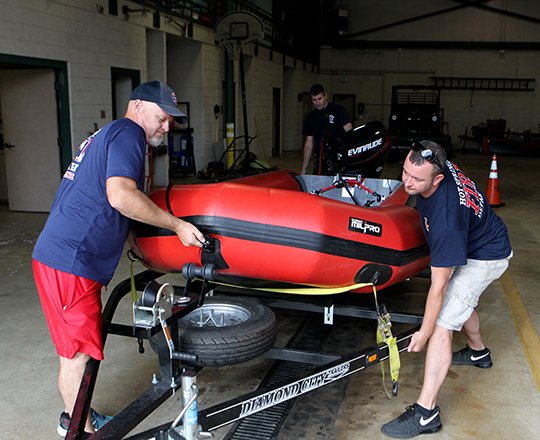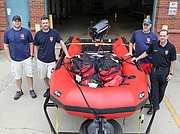As Texas continues to struggle with massive flooding in the aftermath of Hurricane Harvey, a swift water rescue team from the Hot Springs Fire Department and boat groups from area volunteer fire departments were deployed to the area Wednesday morning to help.
"They have a disaster of far-reaching proportions down there and it's not going to end anytime soon," Hot Springs Fire Chief Ed Davis said Wednesday. "There will be standing water in those areas for some time. These guys will likely be getting to folks who, at least until now, have been totally on their own."
Lt. Kenny Talbert, firefighter Blake Harmon and driver Ricky Ilenfeld, all members of the department's swift water rescue team, and Training Officer Ty Farris left Wednesday bound for the Texas A&M Engineering Extension Service training facility at College Station, Texas, which will serve as a staging area for emergency personnel.
"Once we get there we will find out what they need us to do," Farris said. "We don't know what location we will be going to or what our assignment will be at this point."
Farris said his role will be to handle logistics "so they don't have to worry about that and can concentrate on the rescue side. My biggest part will be if they need anything I will work with the command structure down there to get it for them."
He said they were one of 11 departments in Arkansas deploying teams Wednesday through the Arkansas Fire Boat Committee, noting Grant and Clark counties were also sending swift water teams like theirs. "I don't know if they are sending boats or not. We got double tasked and put in both groups, swift water and the boat groups."
Three boat operators from Jessieville's volunteer fire department and four from the Lonsdale department are also part of the deployment, Bo Robertson, Garland County's director of emergency management, said Wednesday.
He said the request for help was issued through the emergency management assistance compact between Texas and Arkansas. Officials in the affected area requested swift water rescue teams from state officials in Texas, he said, and the request then went out to the five states in Region 6 of the Federal Emergency Management Agency.
The Arkansas Department of Emergency Management's Emergency Operations Center passed on the request to local agencies who will be reimbursed as a result of the federal disaster declaration in Texas and the request being issued through the emergency management assistance compact, Robertson said.
Davis said the HSFD "never self-deploys. We always wait until someone contacts us and requests our assistance. It's more structured that way and you're not providing something they don't really want."
While Hot Springs firefighters had previously responded after Hurricane Katrina in August 2005, they were involved in search and rescue efforts going through areas looking for survivors that didn't involve water rescues.
"This will be the first time we've deployed our boat and swift water rescue team out of state," Farris said, noting they had previously done some water rescues in the city and county, including last spring after the Big Mazarn overflowed.
Farris said the fact they are needed for rescues five days after the storm hit "tells you the amount of rain they've had. This is not typical. They had like 55 inches as of last night. This hurricane just stuck around."
He said there was some concern about the remnants of the storm hitting Arkansas "so we might have flooding here," but he noted it looked like it was moving to the southeast and the most recent local forecast was for 1 or 2 inches of rain.
Farris stressed there would still be HSFD swift water rescue team members staying here. "They won't have a boat, but with an inch or so of rain they shouldn't need one. If they have to have a boat they can get one from Lake Hamilton (Fire Department) or get a flat bottom from somebody."
The team's 15-foot Zodiac inflatable boat can hold multiple people as needed. "We had about 13 people on it during training at DeGray (Lake)," Talbert said.
He said the amount of people it is safe to carry "depends on the conditions and the current. If it's a heavy current we will try to take as few as possible at a time so the boat rides higher in the water. We can drop people off and go back."
Davis praised the team, noting, "These guys have a proven track record of wanting to be the folks to make a difference in the community. They train a lot on their own time to be prepared to deal with swift water emergencies. I have every confidence in them they will go down and represent us well."
Davis said they are already making plans for another deployment and will rotate those that did not go this time to replace the crew leaving Wednesday as needed.
He said the flooding in Texas "is reportedly a record for the continental U.S.," noting, "It's pretty amazing. One article said this was an 800-year flood."
He said after it hit it seemed like the hurricane "was kind of bouncing off the coast back into the ocean. It wasn't moving. Just kind of oscillating. With those kind of moisture levels, it's just disastrous."
Staff writer David Showers contributed to this article.
Local on 08/31/2017

